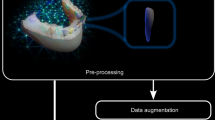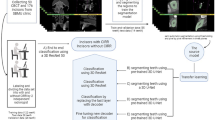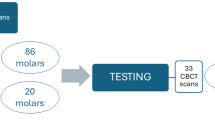Abstract
This paper aims to combine two different imaging techniques to create an accurate 3D model representation of root canals and dental crowns. We combine Cone-Beam Computed Tomography (CBCT) (root canals) and Intra Oral Scans (IOS) (dental crowns). The Root Canal Segmentation algorithm relies on a U-Net architecture with 2D sliced images from CBCT scans as its input. The segmentation task achieved an F1-score of 0.84. The IOS segmentation (Dental Model Segmentation) algorithm and Universal Labeling and Merging (ULM) algorithm use a multi-view approach for 3D shape analysis. The approach consists of acquiring views of the 3D object from different viewpoints and extract surface features such as the normal vectors. The generated 2D images are then analyzed via a 2D convolutional neural networks (U-Net) for segmentation or classification tasks. The segmentation task on IOS achieved an accuracy of 0.9. The ULM algorithm classifies the jaws between upper and lower and aligns them to a template and labels each crown and root with the ‘Universal Numbering System’ proposed by the ‘American Dental Association’. The ULM task achieve an F1-score of 0.85. Merging and annotation of CBCT and IOS imaging modalities will help guide clinical decision support and quantitative treatment planning for specific teeth, implant placement, root canal treatment, restorative procedures, or biomechanics of tooth movement in orthodontics.
Supported by NIDCR R01 DE024450.
Access this chapter
Tax calculation will be finalised at checkout
Purchases are for personal use only
Similar content being viewed by others
References
Ahlbrecht, C.A., et al.: Three-dimensional characterization of root morphology for maxillary incisors. PLoS One 12(6), e0178728 (2017). https://doi.org/10.1371/journal.pone.0178728
American Dental Association Universal Numbering System. https://radiopaedia.org/articles/american-dental-association-universal-numbering-system. Accessed 5 July 2021
Aubry, M., Schlickewei, U., Cremers, D.: The wave kernel signature: a quantum mechanical approach to shape analysis. In: 2011 IEEE International Conference on Computer Vision Workshops (ICCV workshops), pp. 1626–1633. IEEE (2011)
Berrendero, S., Salido, M., Valverde, A., Ferreiroa, A., Pradíes, G.: Influence of conventional and digital intraoral impressions on the fit of cad/cam-fabricated all-ceramic crowns. Clin. Invest. 20(9), 2403–2410 (2016)
Boubolo, L., et al.: Flyby CNN: a 3D surface segmentation framework. In: Medical Imaging 2021: Image Processing. vol. 11596, p. 115962B. International Society for Optics and Photonics (2021)
Bronstein, M.M., Kokkinos, I.: Scale-invariant heat kernel signatures for non-rigid shape recognition. In: 2010 IEEE Computer Society Conference on Computer Vision and Pattern Recognition, pp. 1704–1711. IEEE (2010)
Citing slicer. https://www.slicer.org/w/index.php?title=CitingSlicer&oldid=63090
Deng, J., Dong, W., Socher, R., Li, L.J., Li, K., Fei-Fei, L.: Imagenet: a large-scale hierarchical image database. In: 2009 IEEE Conference on Computer Vision and Pattern Recognition, pp. 248–255. IEEE (2009)
Dumont, M., et al.: Patient specific classification of dental root canal and crown shape. In: International Workshop on Shape in Medical Imaging, pp. 145–153. Springer (2020)
Elhaddaoui, R, et al.: Resorption of maxillary incisors after orthodontic treatment-clinical study of risk factors. Int. Orthod. 14, 48–64. (2016). https://doi.org/10.1016/j.ortho.2015.12.015
Dental model segmentation. https://github.com/DCBIA-OrthoLab/fly-by-cnn
Root canal segmentation. https://github.com/RomainUSA/CBCT_seg
Universal labeling and merging. https://github.com/DCBIA-OrthoLab/fly-by-cnn/blob/master/src/py/labeling.py, https://github.com/DCBIA-OrthoLab/fly-by-cnn/tree/master/src/py/PSCP
Ioshida, M, et al.: Accuracy and reliability of mandibular digital model registration with use of the mucogingival junction as the reference. Oral Surg. Oral Med. Oral Pathol. Oral Radiol. 127(4), 351–360 (2018). https://doi.org/10.1016/j.oooo.2018.10.003
Kamble, R.H., et al.: Stress distribution pattern in a root of maxillary central incisor having various root morphologies: a finite element study. Angle Orthod. 82, 799–805 (2012). https://doi.org/10.2319/083111-560.1
Kanezaki, A., et al.: Rotationnet: joint object categorization and pose estimation using multiviews from unsupervised viewpoints. In: Proceedings of the IEEE Conference on Computer Vision and Pattern Recognition, pp. 5010–5019 (2018)
Ko, C.C., et al.: Machine learning in orthodontics: application review. Craniof. Growth Ser. 56, 117–135 (2020). http://hdl.handle.net/2027.42/153991
Kwak, G.H., et al.: Automatic mandibular canal detection using a deep convolutional neural network. Sci. Rep. 10, 5711 (2020). https://doi.org/10.1038/s41598-020-62586-8
Liu, M., Yao, F., Choi, C., Sinha, A., Ramani, K.: Deep learning 3D shapes using alt-az anisotropic 2-sphere convolution. In: International Conference on Learning Representations (2018)
Lupi, J.E., et al.: Prevalence and severity of apical root resorption and alveolar bone loss in orthodontically treated adults. Am. J. Orthod. Dentofacial. Orthop. 109(1), 28–37 (1996). https://doi.org/10.1016/s0889-5406(96)70160-9
Ma, C., Guo, Y., Yang, J., An, W.: Learning multi-view representation with ISTM for 3-D shape recognition and retrieval. IEEE Trans. Multimedia 21(5), 1169–1182 (2018)
Machado, J., Pires, P., Santos, T., Neves, A., Lopes, R., Visconti, M.A.: Root canal segmentation in cone-beam computed tomography. Braz. J. Oral Sci. 18, e191627 (2019). DOIurl10.20396/bjos.v18i0.8657328
Marques, L.S., et al.: Severe root resorption in orthodontic patients treated with the edgewise method: prevalence and predictive factors. Am. J. Orthod. Dentofacial. Orthop. 137, 384–388 (2010) https://doi.org/10.1016/j.ajodo.2008.04.024
Marques, L.S., et al.: Severe root resorption and orthodontic treatment: clinical implications after 25 years of follow-up. Am. J. Orthod. Dentofac. Orthop. 139, S166–5169 (2011). https://doi.org/10.1016/j.ajodo.2009.05.032
Ming-Kuei, H.: Visual pattern recognition by moment invariants. IRE Trans. Inf. Theory 8(2), 179–187 (1962)
Oyama, K., et al.: Effects of root morphology on stress distribution at the root apex. Eur. J. Orthod. 29, 113–117 (2007). https://doi.org/10.1093/ejo/cjl043
Paul, A., et al.: User-guided 3D active contour segmentation of anatomical structures: Significantly improved efficiency and reliability. Neuroimage 31(3), 1116–1128 (2006). https://www.itksnap.org
Qi, C.R., Su, H., Mo, K., Guibas, L.J.: Pointnet: deep learning on point sets for 3D classification and segmentation. In: Proceedings of the IEEE Conference on Computer Vision and Pattern Recognition, pp. 652–660 (2017)
Ribera, N., et al.: Shape variation analyzer: a classifier for temporomandibular joint damaged by osteoarthritis. In: Medical Imaging 2019: Computer-Aided Diagnosis, vol. 10950, p. 1095021. International Society for Optics and Photonics (2019)
Riegler, G., Osman Ulusoy, A., Geiger, A.: Octnet: learning deep 3D representations at high resolutions. In: Proceedings of the IEEE Conference on Computer Vision and Pattern Recognition, pp. 3577–3586 (2017)
Ronneberger, O., Fischer, P., Brox, T.: U-Net: convolutional networks for biomedical image segmentation. In: Navab, N., Hornegger, J., Wells, W.M., Frangi, A.F. (eds.) MICCAI 2015. LNCS, vol. 9351, pp. 234–241. Springer, Cham (2015). https://doi.org/10.1007/978-3-319-24574-4_28
Sfeir, R., Michetti, J., Chebaro, B., Diemer, F., Basarab, A., Kouamé, D.: Dental root canal segmentation from super-resolved 3D cone beam computed tomography data. In: 2017 IEEE Nuclear Science Symposium and Medical Imaging Conference (NSS/MIC), pp. 1–2 (2017). https://doi.org/10.1109/NSSMIC.2017.8533054
Shah, N., Bansal, N., Logani, A.: Recent advances in imaging technologies in dentistry. World J. Radiol. 6(10), 794 (2014)
Simonyan, K., Zisserman, A.: Very deep convolutional networks for large-scale image recognition. arXiv preprint arXiv:1409.1556 (2014)
Styner, M., et al.: Framework for the statistical shape analysis of brain structures using SPHARM-PDM. Insight J. 2006(1071), 242 (2006)
Su, H., Maji, S., Kalogerakis, E., Learned-Miller, E.: Multi-view convolutional neural networks for 3D shape recognition. In: Proceedings of the IEEE International Conference on Computer Vision, pp. 945–953 (2015)
Wang, P.S., Liu, Y., Guo, Y.X., Sun, C.Y., Tong, X.: O-cnn: Octree-based convolutional neural networks for 3d shape analysis. ACM Transactions on Graphics (TOG) 36(4), 1–11 (2017)
Wu, Z., et al.: 3D shapenets: a deep representation for volumetric shapes. In: Proceedings of the IEEE Conference on Computer Vision and Pattern Recognition, pp. 1912–1920 (2015)
Xu, X., et al.: 3D tooth segmentation and labeling using deep convolutional neural networks. IEEE Trans. Vis. Comput. Graph. 2019 25(7), 2336–2348. (2019) https://doi.org/10.1109/TVCG.2018.2839685
Zichun, Y., et al.: CBCT image segmentation of tooth-root canal based on improved level set algorithm. In: Proceedings of the 2020 International Conference on Computers, Information Processing and Advanced Education (CIPAE 2020), pp. 42–51. Association for Computing Machinery, New York (2020). https://doi.org/10.1145/3419635.3419654
Author information
Authors and Affiliations
Corresponding author
Editor information
Editors and Affiliations
Rights and permissions
Copyright information
© 2021 Springer Nature Switzerland AG
About this paper
Cite this paper
Deleat-Besson, R. et al. (2021). Merging and Annotating Teeth and Roots from Automated Segmentation of Multimodal Images. In: Syeda-Mahmood, T., et al. Multimodal Learning for Clinical Decision Support. ML-CDS 2021. Lecture Notes in Computer Science(), vol 13050. Springer, Cham. https://doi.org/10.1007/978-3-030-89847-2_8
Download citation
DOI: https://doi.org/10.1007/978-3-030-89847-2_8
Published:
Publisher Name: Springer, Cham
Print ISBN: 978-3-030-89846-5
Online ISBN: 978-3-030-89847-2
eBook Packages: Computer ScienceComputer Science (R0)





